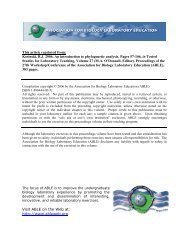Organelle Isolation and Marker Enzyme Assay - Association for ...
Organelle Isolation and Marker Enzyme Assay - Association for ...
Organelle Isolation and Marker Enzyme Assay - Association for ...
Create successful ePaper yourself
Turn your PDF publications into a flip-book with our unique Google optimized e-Paper software.
130 <strong>Organelle</strong> <strong>Isolation</strong><br />
Contents<br />
Student Outline ..............................................................................................................130<br />
Introduction....................................................................................................................130<br />
Cells/Tissue Homogenization........................................................................................130<br />
Differential Centrifugation ............................................................................................131<br />
Density-Equilibrium Centrifugation..............................................................................131<br />
<strong>Marker</strong> <strong>Enzyme</strong>s ............................................................................................................133<br />
The Organism, Dictyostelium discoideum.....................................................................133<br />
Synopsis of the Experiment ...........................................................................................134<br />
Laboratory Protocol .......................................................................................................135<br />
Preparation of Homogenate (steps 1–3).........................................................................135<br />
Centrifugation (steps 4–7) .............................................................................................135<br />
<strong>Assay</strong> <strong>for</strong> Succinate Dehydrogenase..............................................................................136<br />
<strong>Assay</strong> <strong>for</strong> Acid Phosphatase ..........................................................................................136<br />
<strong>Assay</strong> <strong>for</strong> Alkaline Phosphodiesterase...........................................................................137<br />
Tabulation of Results.....................................................................................................137<br />
Notes <strong>for</strong> the Instructor .................................................................................................138<br />
Acknowledgements........................................................................................................139<br />
Literature Cited..............................................................................................................139<br />
Appendix A: Expected Results <strong>and</strong> Examples of Assignment Questions.....................140<br />
Appendix B: Growing Cells of Dictyostelium discoideum............................................142<br />
Appendix C: Materials...................................................................................................144<br />
Student Outline<br />
Introduction<br />
Eukaryotic cells contain several types of intracellular membrane-bound structures known as<br />
organelles which per<strong>for</strong>m a variety of specific functions. For example, mitochondria synthesize<br />
ATP, chloroplasts convert light energy to chemical energy, while the endoplasmic reticulum is<br />
involved in protein synthesis. The types <strong>and</strong> number of organelles in cells range from no organelle<br />
(in mature mammalian red blood cells) to many <strong>and</strong> diverse organelles (<strong>for</strong> example, in cells active<br />
in the synthesis of proteins <strong>for</strong> secretion).<br />
Biochemical analysis of the structure <strong>and</strong> function of organelles requires a relatively pure<br />
sample. There are several methods <strong>for</strong> isolating subcellular organelles (Alberts et al., 1989; Darnell<br />
et al., 1990; Novikoff <strong>and</strong> Holtzman, 1976); in this laboratory you will employ one of the most<br />
widely-used methods, differential centrifugation.<br />
Cells/Tissue Homogenization<br />
An ubiquitous first step in the isolation of subcellular organelles is to homogenize the cells.<br />
This process involves breaking open the cell membrane (<strong>and</strong> the cell wall if present). Commonly<br />
used methods of homogenization include (1) dounce homogenization, where the cells are crushed<br />
between two revolving solid surfaces; (2) filtration, where cells are <strong>for</strong>ced through smaller pores in<br />
a filter; (3) grinding, where cells are ground by swirling with glass beads; (4) sonication, where<br />
cells are bombarded with ultrasonic vibrations; <strong>and</strong> (5) solubilization, in which cell membranes are<br />
dissolved in detergents such as Triton X-100. <strong>Enzyme</strong> digestion is also used to remove cell-wall
















